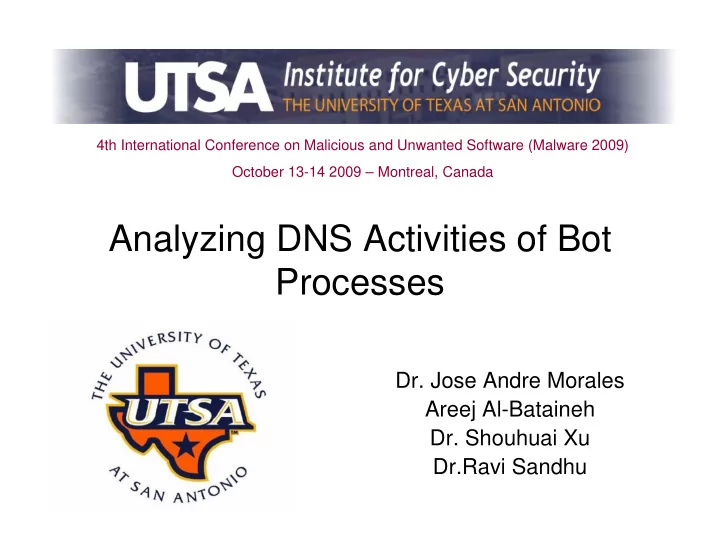

4th International Conference on Malicious and Unwanted Software (Malware 2009) October 13-14 2009 – Montreal, Canada Analyzing DNS Activities of Bot Processes Dr. Jose Andre Morales Areej Al-Bataineh Dr. Shouhuai Xu Dr.Ravi Sandhu
Overview • Attempt to detect bot processes based on a process’s reaction to DNS activity, RD-behavior. • Detect with host based approach that is process- specific • Real-time data collection with post analysis • Detects bots and non-bot malware • Enhances results of some commercial solutions
Bots and DNS • Bots need to join a botnet to be useful • Botmasters provide several IPs or domains to connect with • Brute force connection attempts have many failures • DNS activities: DNS and reverse DNS (rDNS) used to lower the failure rate but produces failed DNS results
RD-behavior - 1 • RD-behavior: a process’s reaction to DNS response behavior • Process will use DNS or rDNS queries for various tasks – How should a process react? – When should DNS result be ignored? – When should a DNS result be used?
RD-behavior - 2 Expected RD-behavior • An IP address that fails a rDNS query is not used in a connection attempt • IP address used in a successful DNS activity should connect. Anomalous (Suspicious) RD-behavior, SRDB • An IP address that fails rDNS query is used in any connection attempt. • IP address of a successful DNS activity is used in a unsuccessful connection attempt.
RD-behavior Tree with 6 paths
Experiments - 1 • Detection occurred after 1 instance of SRDB – 1 instance of P2,P4,P5,P6 • Tested three sets of processes for 1 hour period: – Non-bot malware: Netsky, Bredolab, Lovegate, Brontok, Ursnif • In the wild between January and May 2009 • Worms, Trojan downloaders and Backdoors – Benign: BitTorrent, Kaspersky AV, Cute FTP, LimeWire and Skype • All network active
Bot Properties
Experiments - 2 • Total # distinct IPs/domains in a DNS, rDNS or both and a connection attempt (successful and failed) • Bots had the most, followed by non-bot malware and benign
Experiments - 3 • Every P2 instance has at least one instance of P4-P6 • P2 assumed anomalous but not suspicious and is pruned • Benign had no paths P4-P6 • Malware had instances of paths P4-P6 • P6 most dominant in bots
Experiments - 4 Two commercial bot detectors Rubotted: 9 false negative Anti-bot: 4 false negatives SRDB (RD-behavior): 0 false negatives Combining SRDB with the two commercial bot detectors improved their detection accuracy.
Result Analysis • Benign tend to follow expected RD-behavior • Bots follow expected and SRDB – Especially bots with a pool of domains/IPs to choose from • Non-bot malware exhibit SRDB behavior – Encouraging, results suggest technique can be extended to detect other malware classes • All results acquired in first 7minutes of execution – Early detection mitigates damage and distribution
Limitations • Kernel mode bots • Paths P1, P3 • Beyond join phase • Only TCP traffic • Web 2.0, socnet bots (Twitterbot)
New Results 1 – Sept-Oct 2009 Benign Processes
New Results 1 – Sept-Oct 2009 Malware Processes • 78 samples from CWSandbox malware repository 09-10-2009 • Very diverse, adware, scareware, bots(zbot,harebot), PWS, backdoors, Trojans(all types), Packed Win32 Vxs. • Virustotal, 4 not detected
New Results 2 – Sept-Oct 2009 Malware Processes • P2: 6 instances, P1: 28 instances, No P3 – P6, • Malware observations – DNS many domain names – Each Domain DNS’d many times – Unusual, never seen domain names: .kr,.cn,.NU, etc…
Detection Enhancements • In addition to detecting RD-Behavior • User/machine-based whitelist of commonly visited domain names • Process-based – total domain names DNS’d per execution – total DNS of one domain name • DNS success/failure rate • Combining can produce better results • GOAL: exploit DNS maximally to detect malware (not just bots), usable as one component of bigger detection strategy • Research currently underway
Conclusion and Future Work • Combining DNS & connection attempts very useful in bot detection • rDNS key element of bots • Several bots (non-bot malware) do not follow DNS rules of expected behavior • Benign use DNS activities in expected ways • Future Work - Kernel bot detection – More malware, benign processes – Diversity of protocols – Detection Enhancements presented here
Questions? ¿Preguntas? 質問 質問 Вопросы Вопросы Sawaal Domande Domande Soru Ερωτήσεις Ερωτήσεις 問題 kyseessä pytanie 19
Recommend
More recommend